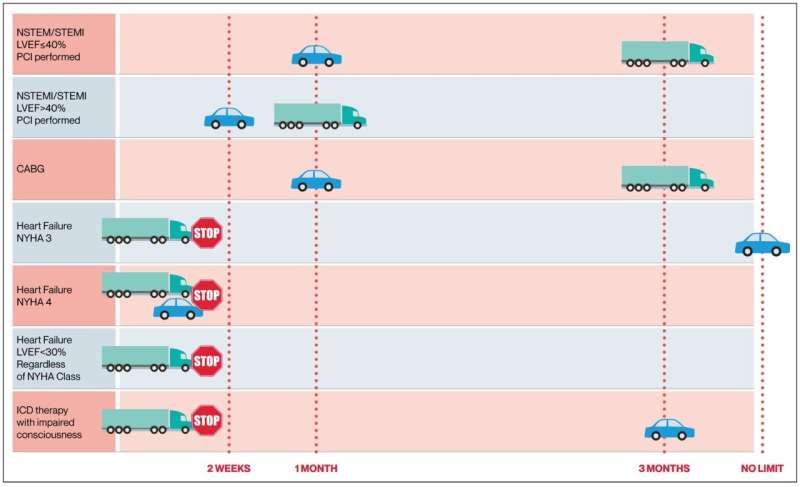This article has been reviewed according to Science X's editorial process and policies. Editors have highlighted the following attributes while ensuring the content's credibility:
fact-checked
peer-reviewed publication
trusted source
proofread
Updated guidelines in Canada to assess private and commercial drivers' fitness to drive

The Canadian Cardiovascular Society (CCS) Fitness to Drive Guidelines have been updated to provide the latest advice on driving restrictions for private and commercial drivers. Using the CCS Risk of Harm formula and available evidence, the Guidelines document the likelihood of sudden cardiac incapacitation and highlight acceptable risk thresholds, providing guidance on when it is and is not safe to allow individuals to resume driving.
Fitness to Drive Guidelines recommendations are aimed at supporting physicians and health care providers to advise people with heart conditions about risks and durations for driving restrictions. Updated by a panel of national experts, these new evidence-based guidelines appear in the Canadian Journal of Cardiology.
Lead co-chair of the updated Guidelines, Peter G. Guerra, MD, Montréal Heart Institute, University of Montréal, says, "Cardiovascular conditions are among the most frequent causes of impairment to driving because they might impair circulation of blood to the brain causing mental state alterations via diverse mechanisms like myocardial infarction, cardiac arrhythmias, and heart failure. Accordingly, health care providers are often asked to assess fitness to drive in patients with cardiac conditions."
The Fitness to Drive Guidelines build on and update the previous Guidelines that have been trusted and relied upon for two decades. The Guidelines take into account new data on therapies, interventions, and disease entities. These include:
- Percutaneous therapies for valvular disease
- Genetic disorders
- Recent studies looking at the risk of shock or incapacitation in patients with implantable defibrillators
Co-chair Christopher S. Simpson, MD, Queens University, Kingston Health Sciences Centre, explains, "Because there are no randomized trials on Fitness to Drive, observational studies were used to estimate the risk of driving impairment in each situation, and recommendations made on the basis of the CCS Risk of Harm formula, which remains the major, validated assessment tool. More restrictive recommendations were made for commercial drivers, who spend longer average times behind the wheel, use larger vehicles, and might transport a larger number of passengers."
The Fitness to Drive Guidelines provide recommendations for people with these seven conditions:
- Active coronary artery disease
- Valvular heart disease
- Heart failure, heart transplant, and left ventricular assist devices
- Arrhythmia syndromes
- Implantable devices (pacemakers and defibrillators)
- Syncope (fainting spells)
- Congenital heart disease
The co-chairs suggest appropriate waiting times after cardiac interventions or acute illnesses before driving resumption. Short-term driving restriction recommendations were derived, in many instances, based on the risk of harm formula as the evidence used demonstrated diminishing levels of risk over time.
Co-chair Harriette G.C. Van Spall, MD, MPH, McMaster University, Hamilton Health Sciences Centre, and Baim Institute for Clinical Research, Boston, notes, "This document, although not a substitute for clinical judgment or governmental regulations, provides clinicians with a comprehensive list of cardiac conditions and their associated risk of sudden incapacitation."
"The recommendations can stimulate discussion with patients and inform decision-making regarding private or commercial driving. In some jurisdictions, they will serve as a trigger for clinicians to notify transportation authorities. Adherence to these recommendations can reduce risk to self and others while behind the wheel but will not eliminate it."
Dr. Guerra concludes, "If a doctor thinks a driver is a risk, in some Canadian provinces, reporting to transportation authorities is mandatory. These are one of the only Guidelines issued for the safety of patients and also for the safety of those around them."
More information: Peter G. Guerra et al, Canadian Cardiovascular Society 2023 Guidelines on the Fitness to Drive, Canadian Journal of Cardiology (2023). DOI: 10.1016/j.cjca.2023.09.033

















